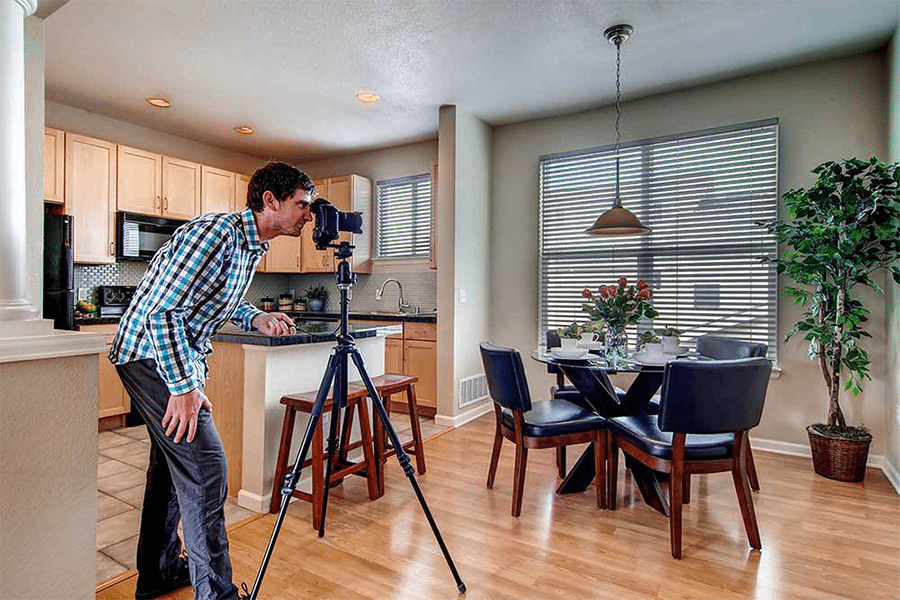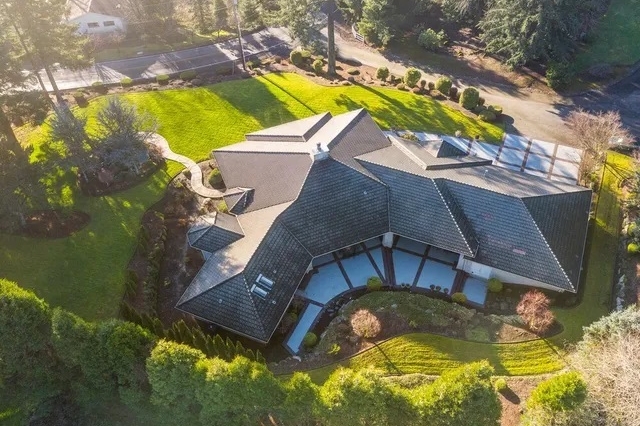Best HDR Software for Real Estate Photography
Editing enables real estate photographers to blend pictures with different exposures to form a single image with a dynamic range. This is why we’re sharing the best HDR software for real estate photographers to ensure you can perfectly capture every detail of your interior and exterior photos.
Considering filters, editing functions, and interface, Adobe Lightroom is our top HDR program to help users edit professional and clean-looking real estate photos.
Adobe Lightroom
Adobe’s Lightroom is a favorite amongst real estate photographers, mainly because of its batch editing, presets, and HDR Merge tools. Its user-friendly toolset also includes gradient filter, brush filter, and HSL sliders for editing specific parts of images and really dial in the finished look.
It has come a long way since its inception, and it has quite a few helpful tools when creating HDR images. Like Adobe Elements, much of your editing functions would come from the HDR Merge Preview.
From there, real estate photographers can choose the Auto Tone tool to produce an evenly-toned merged image right away. Another option is the Auto-Align tool, which is helpful if your exterior shots have slight movements like vehicles passing or people walking.
There’s also a Look-Up Table system for mapping one color into another. With this technique, you can develop distinctive and attention-grabbing visuals for your clients.
Even when users encounter semi-transparent results, you can apply the deghosting option for a cleaner output. More than that, LR offers a Create Stack Option, which groups exposure-bracketed images into a single stack.
The latest version now comes with Panorama. In effect, your pictures form an elongated field of view and blend multiple exposures into one image.
Furthermore, it comes with a nifty profile feature that allows you to convert RAW camera files to viewable images, such as JPEG or PNG. Additionally, users can organize files into catalogs for a convenient way of adding metadata, geotags, and comments.
Similar to Photoshop, users can choose either a monthly or yearly subscription. In this way, you have at least 30 days to decide if this is the right tool for your editing needs.
What We Like
- Automatically synchronizes your work to Cloud storage that users can access anywhere at any time
- Does profile corrections and removes chromatic aberrations from wide-angle lenses
What We Don’t Like
- Limits sharing and doesn’t come with plugin support
Aurora HDR Enhancing Program
Born out of collaboration with photographer Trey Ratcliff, the Aurora HDR Enhancing Program offers an array of editing tools for photo editors who want to produce composites with fine details.
The program’s primary editing functions include Exposure Stacking, Tone Curve, and Graduated HD Filter. After loading your files, the system will let you choose if you need auto-alignment, auto-ghosting, or removal of chromatic aberration.
When editing, you’ll start with the Structure panel for detail and clarity adjustments in an image. Using the slider controls, you can achieve realistic-looking edits by adjusting temperature, lighting, and shadows.
One of the program’s unique functions is the Top & Bottom Lighting, which enables you to separately modify the exposure levels of an image’s top and bottom portions.
Unlike LR, Aurora HDR fails in having diverse presets. This tool tends to have ‘overcooked’ and heavily saturated filters. However, it does have advanced AI tools that analyze an image before applying smart filters to make your edits look extra realistic.
Aside from that, you can use the color grading feature for enhanced color adjustments, which is perfect for pictures showing accurate depictions of the sky, ceiling, or roof. It also has a LUT mapping feature that provides dynamic previews of the different color grading styles.
When combined with the HDR Smart Structure, your shots will show more texture and depth. You can even apply perspective and lens corrections to fix chromatic aberration caused by wide-angle lenses. Using these features lets you produce pictures with accurate highlights, high contrast, and vivid colors.
Finally, Aurora HDR has an incredibly intuitive interface that improves the overall responsiveness and speed. As a result, users can work with multiple layers to use brushes, luminosity masks, and texture overlays.
What We Like
- One-click tools for noise reduction, color adjustments, luminance, and selective editing
- Much like Photomatix Pro, users can enjoy a free trial and use the application after a one-time purchase
What We Don’t Like
- Updates come in newer versions, so you may need to purchase a different version from time to time
Adobe Photoshop Elements 2021
Adobe Photoshop Elements 2021 is one of the most regularly updated photo editors for real estate photographers. Similar to LR, Elements uses Photo Merge Exposure as its basic image composite editing tool to combine various exposure brackets to form a single image.
There’s also a Panorama feature that enables you to compose 2 or more image files. You can apply Tone in ACR to make adjustments in the exposure, add warmth, boost clarity, and eliminate shadows due to variable lighting.
Toning can make dull photos pop. If your shots don’t stand out for some reason, this feature allows you to apply effects to boost luminance and make your image more vibrant. Meanwhile, denoise can remove noise or unnecessary elements so clients can only focus on what matters in your shots.
Moreover, there’s a Group Shot function that allows you to move objects and people. This feature is time-saving when you need to add a lifestyle vibe for clients to visualize what it’s like having people and things in a given space.
This is an ideal platform for users who want to enhance existing images with colors, levels, and lens correction tools. Like Photomatix Pro, this software has everything you’d require to edit, enhance, and change any aspect of your photographs.
Since Photoshop is a photo manipulation program, users can cut out some elements from one image then replace it with another. Hence, PS is the ultimate editing platform for alterations and adding 3D work on multiple layers.
Among the things you could do with this software are, cropping out objects, adjusting color balance, or work in layers. You can even edit menu commands for Fill, Transform, and Stroke commands.
Another incredible thing about using this tool is that real estate photographers can always post-process the same resulting images whenever and however you want. The only problem is that it is not easy to learn, so you may not like it at first as a newbie.
The photography pack comes with photo editing software plus 58 step-by-step guided edits, built-in prints, and gift services to give you an unmatched experience with editing.
Real estate photographers can also avail of the Adobe Creative Cloud Photography Plan to combine the features of both Elements and LR. A free trial is also a good option if you want to add vector-based graphics to your work, as you can also open Illustrator files.
What We Like
- Expansive Cloud storage space
- Lets you shift between automatic and manual editing modes
What We Don’t Like
- May need to buy the latest version every time there’s an update
Photomatix Pro 6
It’s challenging for real estate photographers to add as much detail as possible without making scenes look too staged, overprocessed, or downright unrealistic. Featuring significant upgrades from the older Photomatix versions, Photomatix Pro 6 helps produce breathtaking edits by combining exposures, applying presets, and using color adjustment tools.

Photomatix comes with robust HDR photography rendering methods to customize and make adjustments in a photo. This toolset includes exposure blending, edge-aware brushes, enhanced color controls, as well as distortion and perspective correction tools.
With these functions, you can adjust the hue, saturation, contrast, sharpness, and brightness of every image.
Furthermore, this Photomatix Pro version offers Tone Balancer. This tool is a new contrast optimizer that finetunes shadows and highlights to achieve more natural results, making the sky or background appear more realistic.
What’s also notable about Photomatix Pro is its ability to produce timelapse videos by batch processing bracketed JPEG images.
Photomatix Pro also provides presets that work best for interior and exterior photography. Likewise, users can change the display of preset thumbnails and save custom presets.
Unfortunately, the interface of Photomatix looks a bit dated if you compare it with other new photo-enhancing and editing tools. This is because Photomatix has been in the industry for a very long time now. However, the functionality and effectiveness of this software remain solid.
What We Like
- Photomatix can serve as a standalone application or plugin
- Uses batch processing mode to blend exposures and change colors for pictures and videos selectively
What We Don’t Like
- The interface of Photomatix Pro isn’t as intuitive as other programs and tends to lag when not updated
Factors to Consider for the Best HDR Program for Real Estate Photographers
A professional real estate image must include a well-lit interior along with a natural-looking exterior. Remember, every small detail matters in real estate photography, and great software should seamlessly bring these out. However, your post-production software must have these features.
Post-Processing Capabilities
If you have a good camera, you will most likely get a good real estate photo. However, you will need a set of editing tools in your program to make your HDR photography stand out and appeal to your clients more.
For example, Adobe LR and Elements mainly use the Photo Merge function to merge bracketed pictures automatically. Photomatix Pro and Aurora also have auto-merge functions. However, they have better Auto Tone and Exposure Stacking features for showing more detailed highlights and shadows.

Ease of Use
Some programs have complicated interfaces that make it hard to post-process a raw image. Fortunately, most of the software we included in this guide has uncomplicated interfaces that even a beginner photographer can use.
For instance, LR and Aurora have better interfaces thanks to their distraction-free workspaces, allowing you to focus on the image. Since you get quick access to your image gallery, it’s easy to toggle between different property HDR images while making adjustments.
Elements, on the other hand, is a bit hard to use, especially if you’ve never used it before. Go with LR or Photomatix Pro if you’re new to this, yet you need photography software that won’t give you a headache.
Compatible File and Video Formats
Each program has its own unique file format. However, it should easily convert images to a format supported by other devices you might use while showing them to clients. All the editing programs in this guide support popular file formats like JPEG and PNG.
When you convert images to these file formats, you can quickly view them with the clients on your computer or phone. Users can also seamlessly compress and upload them to listing websites, advertising channels, or online portfolios.
Elements and LR use the PSD extension. They also accept PSB, which is a large document format, although some smartphones may not be able to view this file. On the other hand, Aurora and Photomatix Pro work best when using RAW pictures.
Cross-Platform Compatibility
As a real estate photographer, you would probably work with different operating systems on your computer. A good editing program should be compatible with the majority of operating systems available.
Cross-platform compatibility for software is vital, especially when you’re using different platforms or devices. In this way, you will not have to go through the hassle of buying another software or limit yourself to a single operating system.
For instance, you must use at least Windows 10 or Mac Mojave to run Adobe LR and Elements. Meanwhile, Aurora and Photomatix are better options for users with older operating systems like Mac Catalina.
Licensing
Licensing is another crucial aspect, particularly if you’re working with a team of real estate photographers. Some software licenses will restrict you to only one computer, while others will give you the freedom to use a single subscription on multiple devices at once.
LR and Elements allow you to sign in on a single account for up to 2 devices simultaneously. If you want automatic updates, it would be better to use Elements and LR, even if you have to secure monthly or yearly subscriptions.
Meanwhile, you only need a one-time license purchase from Photomatix and Aurora. However, the updates would come on the newer versions. Photomatix only lets you use the account for up to 2 devices, whereas Aurora is much better when you need 5 people working at the same time.
Conclusion
Getting the best HDR program is essential if you want to produce high-quality images that can outshine competitors and attract clients. In this way, real estate photographers can offer premium photoshoot and editing services to realtors and sellers to boost business sales this year.




